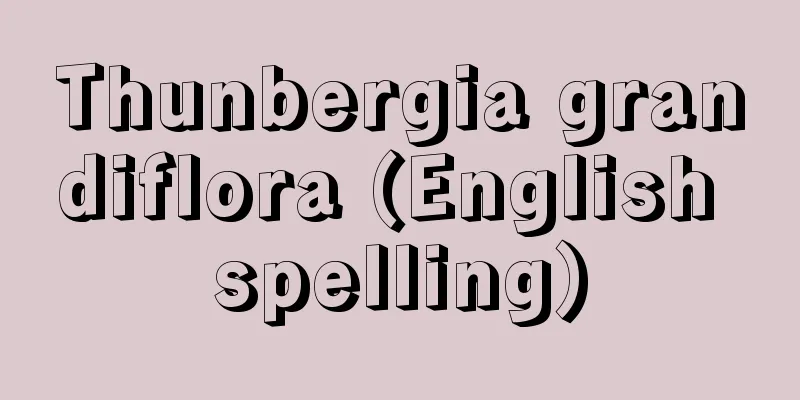Support - Shiho

|
This refers to a structure that supports the ceiling and tunnel walls and is constructed to prevent rock falls, falling rocks, and soil collapse in mines, tunnel construction, etc. [Kinoshita Shigenori] kindsThere are four types of support for tunnels and tunnels: timber support, steel support, lining, and rock bolting. Timber support is the simplest type of support, using tunnel timber, and there are various methods such as three-frame, gable frame, molar frame, and double frame. However, the three-frame method is overwhelmingly more common in terms of usage. This is a gate-shaped structure made by placing one capping on two wooden pillars, and fixing them to the surrounding rock and adjacent frames with wedges and arrow beams. In soft rock, arrows and sheet piles are used around the perimeter to prevent crushed debris from leaking between the frames. Steel support is a support made by combining steel materials (old rails, I- or H-shaped steel) in an arch shape, and two members are connected at the top and the joints are usually bolted with appropriate joint plates. Lining is a method of covering the tunnel by filling the tunnel with concrete, concrete blocks, or brickwork. Rock bolting is used to support tunnels, mine passages, shafts, and other semi-permanent tunnels. After tunnel excavation, holes are drilled into the roof, side walls, and sometimes the floor, and bolts are driven into the rock to secure it and prevent it from collapsing or separating. There are several methods for fastening bolts to the rock, including the wedge method, expansion shell method, and resin pouring to completely bond the bolt to the hole wall. Recently, a method called NATM (New Austrian Tunnelling Method) has become popular, in which after driving in rock bolts and providing temporary supports, mortar or concrete is immediately sprayed to cover the tunnel, and complete lining is performed at an appropriate time. This method has been recognized as being very effective in maintaining tunnels in soft rock. [Kinoshita Shigenori] Coal mine supportIn coal mines where coal seams are extracted, it is extremely important to maintain the mining face (called the mining face), which moves with the mining process, and so the mining face support has developed in a unique way. Until around 1950, pit timber was mainly used for face support, and mining was mostly done by picks and blasting, but after that, face support using cotters and iron poles was introduced, and mining machines such as coal cutters and hovers came to be used for mining. The first iron poles were friction iron poles, but with the advancement of hydraulic equipment they were replaced by hydraulic iron poles, and more recently, they have advanced further and a type of support called a self-propelled support that can be moved by hydraulic operation has been developed, contributing to the automation and complete mechanization of the coal mining face. Self-propelled supports include a frame that combines several hydraulic iron poles and cotters, and a shield frame that uses a shield instead of a cotter. However, full mechanization of the mining face using a self-propelled frame is limited to coal beds with a gentle inclination of 30 degrees or less, and has not yet been achieved in steep inclination coal beds with an inclination of 30 degrees or more. There are a considerable number of steeply inclined coal beds in Japan, and in order to safely mine these coal beds, mechanization of the support for steeply inclined coal mining faces is an important issue, along with mechanization of mining itself. [Kinoshita Shigenori] [Reference] | |Source: Shogakukan Encyclopedia Nipponica About Encyclopedia Nipponica Information | Legend |
|
鉱山、トンネル工事などにおいて、落盤、落石、土砂の崩落などを防止するために施工される、天井および坑壁を支持する構造物をいう。 [木下重教] 種類坑道やトンネルの支保工としては、木材支保、鋼材支保、覆工、ロックボルト工法の4種類がある。木材支保は、坑木を用いて行うもっとも簡単な支保で、三つ枠、合掌枠、モル枠、二重枠など種々の方法がある。しかし使用例からみると三つ枠が圧倒的に多い。これは、2本の木柱に1本の笠木(かさぎ)をのせて門形に組み、くさび、矢木で周囲の岩盤や隣接枠に固定して支保するものである。軟弱な岩盤では、周囲に差矢、矢板掛けなどを行って破砕ずりの枠間漏れを防ぐ。鋼材支保は、鋼材(古レール、IまたH型鋼)をアーチ状に組み合わせて支柱とするもので、2本の部材を頂上で連結し、継ぎ目には適当な継ぎ目板を用いてボルト止めする方法が普通である。覆工は、コンクリートの場所詰め、コンクリート・ブロックまたはれんが積みなどによって、坑道を被覆する工法である。トンネル、鉱山における通洞、立坑など半永久的に使用される坑道の支保に採用される。ロックボルト工法は、坑道掘削後、天盤、側壁、場合によっては床盤に削孔し、ボルトを打ち込んで岩盤を緊定し、岩盤の崩壊、分離を防ぐ工法である。ボルトを岩盤に固着する方法には、くさび式、エキスパンションシェル式、および樹脂を流し込んでボルトを孔壁に全面接着するなどの方式がある。最近はNATM(ナトム)(new austrian tunnelling method)工法といって、ロックボルト打設や仮支保を施したのち、ただちにモルタルやコンクリートを吹き付けて坑道を被覆し、適当な時期に完全覆工を行う工法が普及してきたが、これは軟弱な岩盤の坑道維持に非常に効果があることが認められている。 [木下重教] 炭鉱における支保炭層を採掘している炭鉱では、採掘とともに移動する採炭面(採炭切羽(きりは)という)を維持することはきわめて重要であり、切羽支保として独得の発達を遂げてきた。1950年ころまでの切羽支保は主として坑木が用いられ、採掘もピック、発破による場合がほとんどであったが、その後カッペと鉄柱による切羽支保が導入され、採掘もコール・カッター、ホーベルなどの機械が利用されるようになった。最初の鉄柱は摩擦鉄柱であったが、油圧機器の進歩に伴って油圧式鉄柱にかわり、最近ではさらに進歩し、油圧操作によって移動できる自走支保とよばれる支保が開発され、採炭切羽の無人化と完全機械化に貢献している。自走支保には、数本の油圧鉄柱とカッペを組み合わせた組枠、およびカッペのかわりにシールドを用いたシールド枠がある。しかし自走枠を用いた切羽の完全機械化は、炭層の傾斜が30度以下の緩傾斜層に限られ、炭層傾斜が30度以上の急傾斜層ではまだ達成されていない。わが国には急傾斜の炭層がかなりあり、これらの炭層を安全に採掘するには、急傾斜採炭切羽の支保の機械化は採掘の機械化と並んで重要な課題である。 [木下重教] [参照項目] | |出典 小学館 日本大百科全書(ニッポニカ)日本大百科全書(ニッポニカ)について 情報 | 凡例 |
Recommend
Dynamic height of sea surface
In the ocean, the method of estimating ocean curre...
Zosteropidae
…However, keeping wild birds as pets is now prohi...
Ryu Imanishi
Korean history scholar. Born in Gifu Prefecture. ...
Annan Kingdom - Annan Kingdom
...From the 16th century onwards, northern Vietna...
Regular ships and non-regular ships - teiikisen teiikisen
A ship that operates on a specific route according...
Újvidek (English spelling) Ujvidek
...Population: 180,000 (1991). Hungarian name: Új...
Japanese thread wholesaler - Waitodonya
During the Edo period, this was a receiving wholes...
Ewerbeck, H.
The first turning point came in May 1939, when th...
Mount Akita - Mount Akita
⇒ Mt. Komagatake Source: About Shogakukan Digital ...
Tussi
The Watutsi, also known as the Tussi, are a peopl...
Externalization - Gaika
…the translation of the English alienation, Frenc...
First National City Corp. (English)
…Headquarters: New York. Founded in 1967 as a hol...
Dipodidae
…A general term for mammals of the Dipodidae fami...
Iridosmine - Iridosmine (English spelling)
Osmium is a mineral that occurs in basic plutonic...
Creator - Uminooya
1. The parents who gave birth to me. My biological...









